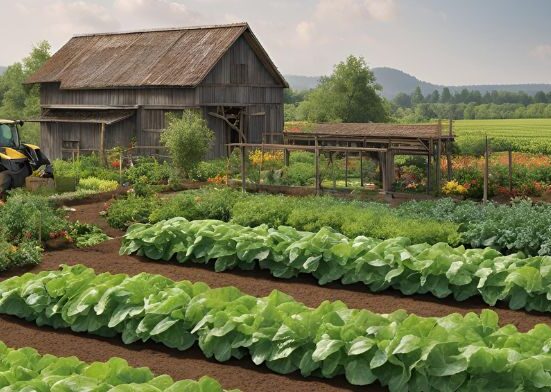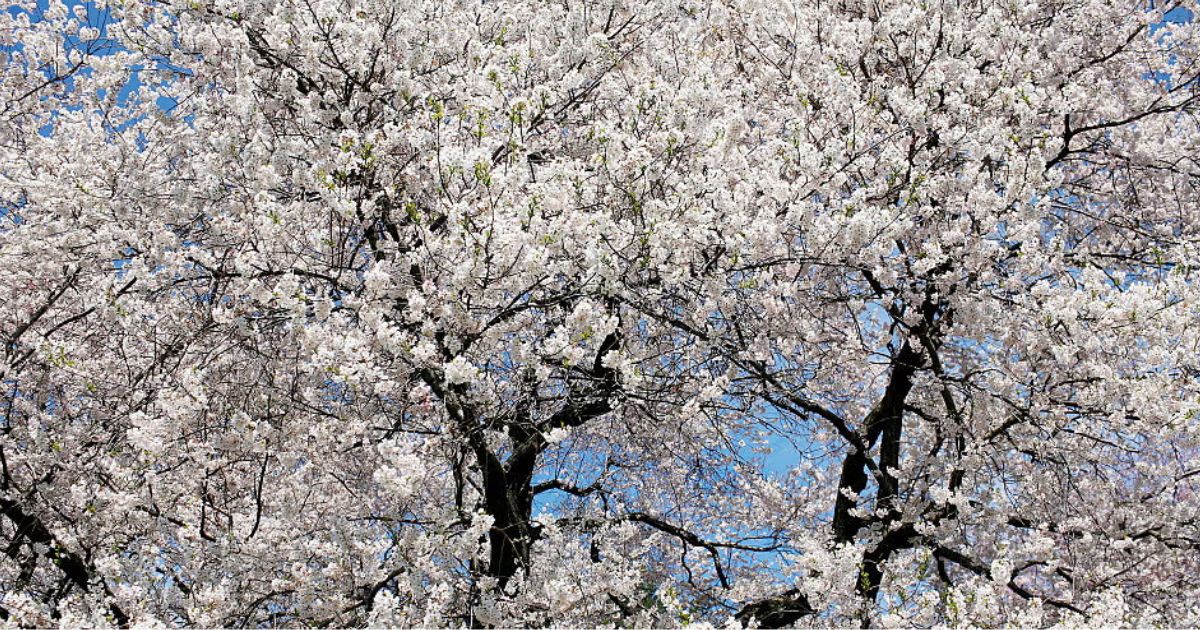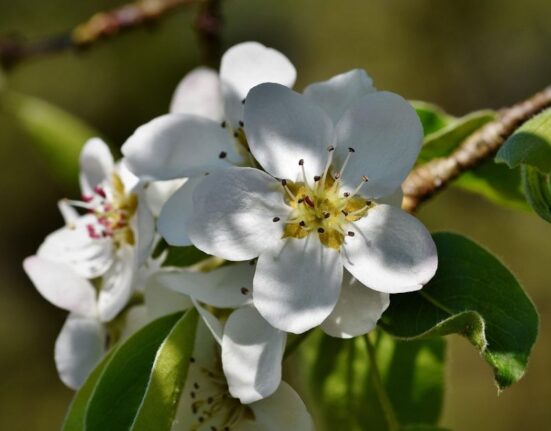There’s something magical about the first signs of spring. After months of cold, grey days, the sight of delicate white blossoms bursting open signals the arrival of warmer weather and new beginnings. Early spring white flowering trees not only transform landscapes with their breathtaking beauty but also bring a sense of freshness, purity, and renewal to your surroundings.From the soft, star-shaped blooms of magnolias to the elegant clusters of dogwoods, these trees create stunning focal points in gardens, yards, and parks. They’re also pollinator-friendly, attracting bees and butterflies at a time when food sources are scarce, making them both beautiful and beneficial.
In this blog, we’ll explore some of the most stunning early spring white flowering trees, their unique features, growing conditions, and care tips. Whether you’re planning to enhance your home garden or love admiring spring blooms, these trees will inspire you to welcome the season in style.
1. Star Magnolia (Magnolia stellata)
The Star Magnolia is a compact, slow-growing tree or large shrub that bursts into bloom in early spring, often before other trees. Its star-shaped, pure white flowers, Orchard Trees: Fruitful Growing A Comparative Guide sometimes with a hint of pink, emit a light, sweet fragrance. blossoms trees spring Reaching heights of 15–20 feet, this tree is perfect as a focal point in huge landscapes or in small gardens.
Key Features:
- Bloom Time: Early spring (March–April)
- Flower Size: 3–5 inches across
- Growth Rate: Slow, 1–2 feet per year
- Hardiness Zones: 4–8
- Care Tips: Plant in well-drained, slightly acidic soil with full sun to partial shade. Mulch to retain moisture and protect roots.
- Why It’s Stunning: The delicate, radiant blooms contrast beautifully against the tree’s bare branches, creating a striking silhouette.
Star Magnolias are low-maintenance and resistant to most pests, making them a favourite for homeowners looking to add elegance without extensive upkeep.
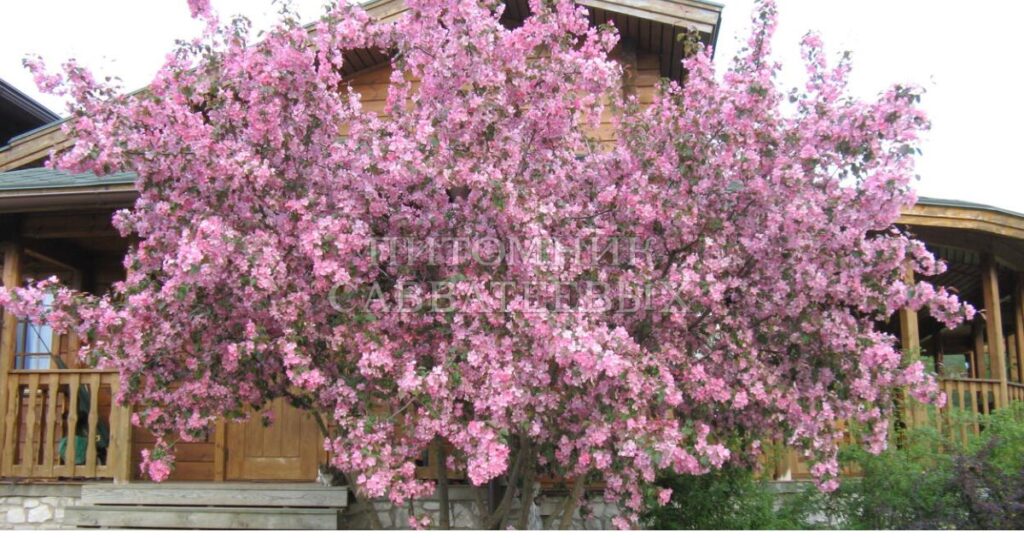
2. Flowering Dogwood (Cornus florida)
The Flowering Dogwood is a classic North American native, known for its elegant white bracts that resemble petals. These “flowers” surround tiny yellow-green true flowers, creating a showy display in early spring. Growing to 20–40 feet, it’s perfect for woodland gardens or as an understory tree.
Key Features:
- Bloom Time: April–May
- Flower Size: 3–4 inches across (bracts)
- Growth Rate: Moderate, 1–2 feet per year
- Hardiness Zones: 5–9
- Maintenance Advice: Prefers moist, well-drained soil and light shade. Avoid heavy pruning to maintain its natural shape.
- Why It’s Stunning: The white bracts, paired with vibrant red berries in fall, offer year-round interest.
Dogwoods also attract birds, adding ecological value to their ornamental appeal. Their trees with white blossom are a staple in many traditional gardens.
3. Serviceberry (Amelanchier spp.)
Serviceberry trees, also known as Juneberries or Shadbush, are multi-seasonal beauties with clusters of delicate white flowers in early spring. These trees grow to 15–25 feet and produce edible berries that attract wildlife. Their versatility makes them suitable for hedges, borders, or standalone specimens.
Key Features:
- Bloom Time: March–April
- Flower Size: Small, clustered, about 1 inch
- Growth Rate: Moderate, 1–2 feet per year
- Hardiness Zones: 4–9
- Tolerant of various soil types, including clay.
- Why It’s Stunning: The airy white blooms, followed by colourful berries and brilliant fall foliage, make this tree a year-round star.
Serviceberries are an excellent choice for sustainable landscapes, white flowering trees identification supplying food for both people and birds and aiding pollinators.
4. Crabapple (Malus spp.)
Certain crabapple varieties, like ‘Snowdrift’ or ‘White Cascade,’ produce stunning white blossoms in early spring. These small to medium-sized trees (15–25 feet) are known for their vibrant flowers and colourful fruit, which persist into fall and winter.
Key Features:
- Bloom Time: April–May
- Flower Size: 1–2 inches across
- Growth Rate: Moderate, 1–2 feet per year
- Hardiness Zones: 4–8
- Care Tips: Choose disease-resistant varieties and plant in full sun with well-drained soil. To preserve form and enhance air circulation, prune.
- Why It’s Stunning: The profusion of white flowers creates a cloud-like effect, and the fruit adds seasonal interest.
Crabapples are excellent for urban gardens, as they tolerate pollution and adapt to various soil conditions.
5. Hawthorn (Crataegus spp.)
Hawthorns, particularly varieties like ‘Winter King,’ offer clusters of white flowers in early spring, followed by bright red berries. These spring flower tree grow to 15–30 feet and are known for their thorny branches, Types of Peaches: A Comprehensive Guide to This Juicy Fruit which provide natural protection for nesting birds.
Key Features:
- Bloom Time: April–May
- Flower Size: Small, clustered, about 0.5–1 inch
- Growth Rate: Moderate, 1–2 feet per year
- Hardiness Zones: 3–8
- Care Tips: Plant in soil that drains properly and in full sun. Prune to remove dead wood and maintain structure.
- Why It’s Stunning: The white flowers contrast beautifully with glossy green leaves, and the berries add winter interest.
Hawthorns are hardy and adaptable, making them an excellent choice for rugged landscapes or wildlife-friendly gardens.
6. Pearlbush (Exochorda spp.)
Pearlbush is a lesser-known gem, with cascading clusters of pure white, pearl-like buds that open into stunning flowers in early spring. Growing to 10–15 feet, it’s perfect for borders or in smaller gardens as a specimen plant.
Key Features:
- Bloom Time: April–May
- Flower Size: 1–1.5 inches across
- Growth Rate: Moderate, 1–2 feet per year
- Hardiness Zones: 4–8
- Prune after flowering to encourage new growth.
- Why It’s Stunning: The pearl-like buds and abundant blooms create a soft, romantic aesthetic.
Pearlbush is easy to grow and adds a unique texture to spring landscapes, making it a delightful addition for creative gardeners.
7. White Fringe Tree (Chionanthus virginicus)
The White Fringe trees with white blooms, a native to the southeastern U.S., produces feathery, fragrant white flowers that dangle like delicate fringe in early spring. Growing to 15–30 feet, it’s an excellent choice for mixed borders or as a specimen tree.
Key Features:
- Bloom Time: April–May
- Flower Size: 4–8 inches long (panicles)
- Growth Rate: Slow to moderate, 1–2 feet per year
- Hardiness Zones: 3–9
- Soil. Tolerates drought once established.
- Why It’s Stunning: The airy, fringe-like flowers create a cloud-like effect, Top 8 Vegetables to Plant in Spring for a Thriving Garden and the tree’s dark green foliage adds contrast.
This trees with white blossoms in early spring is a pollinator magnet and offers a soft, graceful look that’s perfect for naturalistic gardens.
8. Japanese Snowbell (Styrax japonicus)
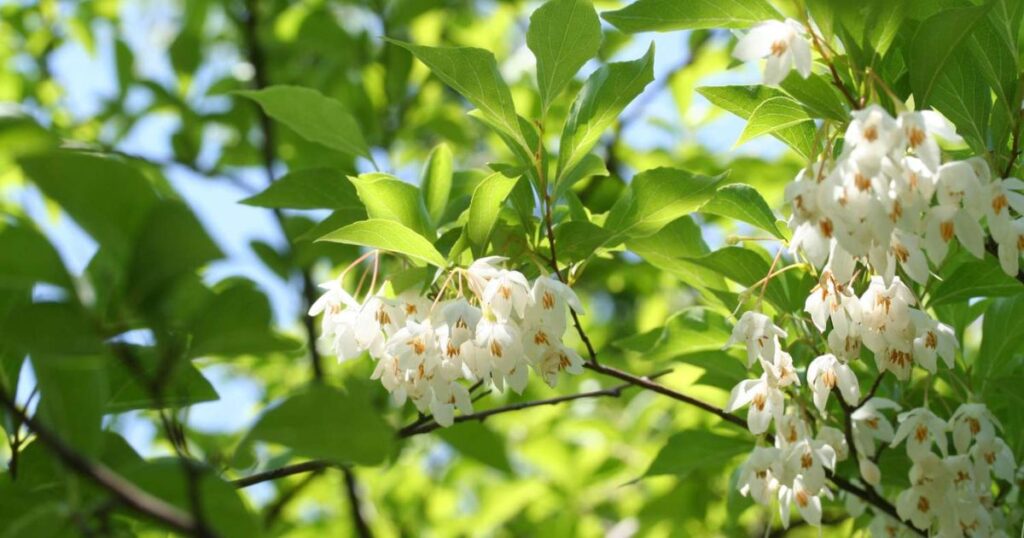
The beautiful Japanese snowbell springtime trees blossom has pendulous, bell-shaped white flowers that hang beneath its branches in early spring. Growing to 20–30 feet, it’s ideal for small to medium-sized gardens.
Key Features:
- Bloom Time: April–May
- Flower Size: 0.5–1 inch across
- Growth Rate: Moderate, 1–2 feet per year
- Hardiness Zones: 5–8
- Slightly acidic soil. Protect from strong winds.
- Why It’s Stunning: The dangling flowers resemble tiny snowbells, creating a whimsical, serene effect.
Japanese Snowbells are low-maintenance and add a touch of elegance to any landscape, especially when planted near patios or walkways.
9. Carolina Silverbell (Halesia carolina)
The Carolina Silverbell is a charming native tree that features early spring blooms of bell-shaped, white flower clusters. Growing to 20–40 feet, What Is an Orchard it’s perfect for woodland gardens or as an understory tree.
Key Features:
- Bloom Time: April–May
- Flower Size: 0.5–1 inch across
- Growth Rate: Moderate, 1–2 feet per year
- Hardiness Zones: 4–8
- Care Tips: Plant in partial shade with moist, well-drained soil. Avoid overly dry conditions.
- Why It’s Stunning: The delicate, dangling flowers and attractive bark create a refined, understated beauty.
Carolina Silverbells are an excellent choice for shaded areas and add a soft, natural charm to spring landscapes.
10. Yoshino Cherry (Prunus x yedoensis)
The Yoshino Cherry, famous for its role in Washington, D.C.’s cherry blossom festival, produces clouds of soft white to pale pink flowers in early springtime trees. Growing to 20–40 feet, it’s a showstopper in any landscape.
Key Features:
- Bloom Time: March–April
- Flower Size: 1–1.5 inches across
- Growth Rate: Moderate, 1–2 feet per year
- Hardiness Zones: 5–8
- Care Advice: Use well-drained soil and plant in full sun. To preserve the tree’s shape and remove dead branches, lightly prune.
- Why It’s Stunning: The masses of white blossoms create a breathtaking, cloud-like display that’s synonymous with spring.
Yoshino Cherries are perfect for creating a dramatic spring focal point, especially in larger landscapes or public spaces.
Why Choose White Flowering Trees for Early Spring?
White flowering trees are a timeless choice for early spring landscapes. Their bright, clean blooms symbolise purity and renewal, making them ideal for celebrating the season’s arrival. These trees also offer practical benefits:
- Pollinator Support: White flowers attract bees, butterflies, and other pollinators, boosting biodiversity.
- Versatility: From compact shrubs like Star Magnolia to taller trees like Yoshino Cherry, there’s a white flowering tree for every garden size.
- Year-Round Interest: Many of these trees offer colourful berries, attractive bark, Lilac Flower: Meaning Growing Tips and Seasonal Beauty or vibrant fall foliage, ensuring beauty beyond spring.
- Low Maintenance: Most are hardy and adaptable, requiring minimal care once established.
Tips for Incorporating White Flowering Trees into Your Landscape
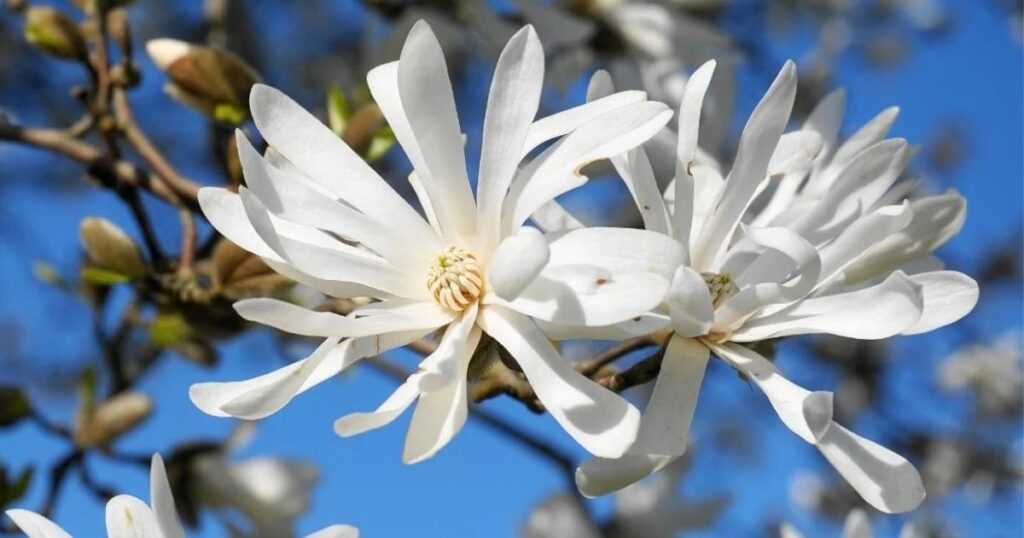
- Mix Sizes and Textures: Combine smaller trees like Pearlbush with taller ones like Flowering Dogwood for depth and interest.
- Consider Bloom Times: Stagger bloom times (e.g., Star Magnolia in March, Crabapple in April) for a prolonged spring display.
- Plant for Pollinators: Placetrees with white blooms in early spring near vegetable gardens or flower beds to attract beneficial insects.
- Use as Focal Points: A single Yoshino Cherry or Japanese Snowbell can anchor a garden or frame a pathway.
- Pair with Contrasting Colours: White flowers pop against evergreen backdrops or colourful spring bulbs like tulips and daffodils.
Care and Maintenance Tips
To ensure your white flowering trees thrive, follow these general guidelines:
- Soil: Most prefer well-drained, slightly acidic soil. Amend with compost if needed.
- Particularly during the first year.
- Pruning: Prune after flowering to avoid cutting off next year’s buds. Remove dead or crossing branches to maintain health.
- Fertilising: Apply a balanced, slow-release fertiliser in early spring to promote growth.
- Pest Control: Monitor for common pests like aphids or scale, and use organic treatments when possible.
Conclusion
Early spring white flowering trees are nature’s way of announcing that winter is finally over and a fresh season of growth has begun. Their delicate, snowy blooms brighten up landscapes, add instant curb appeal, and create a serene, elegant atmosphere in any garden or yard. Beyond their beauty, many of these trees also support pollinators, provide shade, and even offer fruits or berries later in the year, making them a perfect blend of aesthetics and functionality.
Whether you choose the graceful dogwood, the fragrant magnolia, or the charming serviceberry, there’s a white flowering tree to suit every style and space. With the right selection, proper planting, and a little care, flowering white tree you can enjoy a breathtaking spring display year after year.So, if you’re looking to refresh your landscape and welcome spring in style, consider planting one (or more!) of these early blooming white flowering trees. Their timeless beauty will transform your outdoor space and make every spring feel like a new beginning.
FAQ
Which early spring white flowering tree blooms the longest?
The Serviceberry (Amelanchier) and White Crabapple (Malus’ Spring Snow’) are known for their long-lasting white blooms, often staying vibrant for up to 2–3 weeks in early spring.
Are early spring white flowering trees suitable for small gardens?
Yes! Compact varieties like Japanese Snowbell, Fringe Tree, and Star Magnolia are perfect for small gardens. They offer stunning white blooms without taking up too much space.
Do early blooming white trees attract pollinators?
Absolutely. Trees like Dogwoods, Magnolias, and Cherry Blossoms are excellent for attracting bees, butterflies, and other pollinators, providing them with an essential early-season food source.
How do I protect white flowering trees from late spring frost?
Cover smaller trees with frost cloths or light blankets overnight when frost is expected. For larger trees, mulching around the base and watering the soil well can help protect the roots from freezing.
Which early spring white flowering tree has the strongest fragrance?
The Star Magnolia and Fringe Tree are among the most fragrant, filling your garden with a sweet, refreshing scent during early spring.




